| dc.contributor.author | Ringen, Geir | |
| dc.contributor.author | Landsem, Kristin Lorentzen | |
| dc.contributor.author | Holtskog, Halvor | |
| dc.date.accessioned | 2023-03-07T09:20:22Z | |
| dc.date.available | 2023-03-07T09:20:22Z | |
| dc.date.created | 2023-01-20T21:01:45Z | |
| dc.date.issued | 2022 | |
| dc.identifier.citation | Procedia CIRP. 2022, 109 690-694. | en_US |
| dc.identifier.issn | 2212-8271 | |
| dc.identifier.uri | https://hdl.handle.net/11250/3056324 | |
| dc.description.abstract | Complexity in new product development is claimed to continuously increase, causing challenges that require new and cross-disciplinary solutions. There are at least three major forces causing upheaval in the way we are designing, engineering, producing and using/reusing products: 1) achieving the sustainability goals, 2) availability of digital technology at ever lower costs and 3) personalization and customization of products. This study seeks to investigate future solutions for the street light infrastructure based on Design for X approaches - and enablers and barriers for innovation in the stakeholder network. Light poles are traditionally been an enabler for illuminating the road in a static manner, whilst such structures in the future are predicted to host a multitude of technologies for serving a broader array of functionality. Examples of added value functionality are; crash management, smart control systems for energy saving, ease of maintenance, sensor-service system that provides stakeholders with real time information about the road environment, sensor technology for enabling autonomous driving etc. To explore this functionality, a Design for Excellence product development methodology is used to structure the gathered information from multiple sources. Both a qualitative and quantitative methodologies are used, where the former is conducted by interviewing value chain stakeholders for the complete road light infrastructure domain in one region and the latter is done by a structured questionnaire. The common ground for both approaches is Design for excellence which is regarded as a systematic way of designing products to optimize total benefits over the whole product life span. Findings from this study suggest that safety and reliability are the two most important requirements when designing a light pole for future demands. | en_US |
| dc.language.iso | eng | en_US |
| dc.publisher | Elsevier B. V. | en_US |
| dc.rights | Attribution-NonCommercial-NoDerivatives 4.0 Internasjonal | * |
| dc.rights.uri | http://creativecommons.org/licenses/by-nc-nd/4.0/deed.no | * |
| dc.title | Design for Excellence to Explore Complex Product Service Systems: A Case Study | en_US |
| dc.title.alternative | Design for Excellence to Explore Complex Product Service Systems: A Case Study | en_US |
| dc.type | Peer reviewed | en_US |
| dc.type | Journal article | en_US |
| dc.description.version | publishedVersion | en_US |
| dc.source.pagenumber | 690-694 | en_US |
| dc.source.volume | 109 | en_US |
| dc.source.journal | Procedia CIRP | en_US |
| dc.identifier.doi | 10.1016/j.procir.2022.05.315 | |
| dc.identifier.cristin | 2112282 | |
| cristin.ispublished | true | |
| cristin.fulltext | original | |
| cristin.qualitycode | 1 | |

